Are you looking for an analysis of “the Harlem Dancer” by Claude McKay? Fantastic! Here is the most comprehensive analysis you’ll find anywhere.
First, we want to give some background on both the poem “the Harlem Dancer” and on the poet Claude McKay. Second, we will then do a line by line analysis of “the Harlem Dancer.” Third, we’ll discuss the meaning of “the Harlem Dancer.”
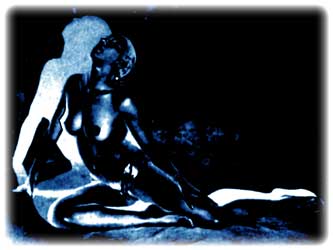
the Harlem Dancer: Background
Imagine a person reads a poem by you, and they are moved to tears. Then they look at you and tell you, “you are such a great black poet.” Have they complemented you? Well, maybe with their tears, but certainly not their words. Because in their words, they’ve made you into a type—they’ve reduced you to a class. It’s condescending to say the least of it, and at its worst, it’s racist. Yet this is at least a little bit of the situation that Claude McKay faced when he first started trying to publish poetry in the United States. The perception, especially on the left, was that as McKay was a poet of colored skin, he should try to express himself that way.
The magazine where “the Harlem Dancer” first appeared, Seven Arts, was an avant guard literary magazine with clear leftist views. They published poems from several different poets, many of whom are now quite famous. Just to mention two names, Robert Frost and D.H. Lawrence. They published two of Claude McKay’s poems in their October 1917 issue—and titled the entry “Two Sonnets.” These sonnets were, “Invocation” and “the Harlem Dancer.” Both poems were published under the pseudonym Eli Edwards. Unfortunately, both poems were chosen among other potential selections at least in part because of their racial content—because it was expected that “black” poets must write about “black” experience. Worse, the biography of the poet was written as, “Eli Edwards is the pen-name of a young negro who makes his living as a waiter in a New York club.” As if saying that the poet was a “young negro” sums up the main part of his existence.
What makes matters worse is that McKay excelled in classical forms of poetry. As “the Harlem Dancer” and many of his other poems demonstrate, he was a master of the Shakespearean sonnet. Have you ever tried to write a sonnet? Do you have any idea how hard it is to achieve, meter, rhyme, and appropriate theme—yet, McKay was a master. What’s more is McKay, while not at all afraid to deal with racial themes, mostly was interested in that which was universal in man’s experience—be it apprehension of discrimination or simply the beauty of a flower. Yet, early on he had difficultly publishing because as a “negro,” it was expected he must express himself as a “negro”—and using classical forms such as the Shakespearean sonnet were deemed inappropriate—even by those on the left expressing solidarity with the oppressed. While we admit, editors on the left frowned on classical forms in general, they especially found it unagreeable that someone from an “oppressed race” would want to make use of such classical forms.
We think it is important to point out how universal “the Harlem Dancer” is as a poem—and that as much as necessary it needs to be elevated away from some type of parochial view that it merely represents a “black man’s” view or an “African-American’s” view or even just an “American’s” view. All these labels do McKay’s poetry a serious injustice. McKay’s poetry succeeds because he transcends these simple classifications and is always able to express universal truths about mankind in general, this is so whether he is dealing with a topic as grim as a lynching with clear racial implications or whether he is simply writing about the beauty of a flower. Claude McKay well understood the difficulties that perceptions of race create, but he wanted to transcend these perceived differences. We would encourage anyone to read his beautiful poem, The Barrier, if they do not believe this.
In an letter to William Stanley Braithwaite, the editor of another important contemporary literary magazine, McKay had this to say about his experience of publishing “the Harlem Dancer” and “Invocation” in Seven Arts [cited in Claude McKay, A Black Poet’s Struggle for Identity by Tyrone Tillery]:
When I was in New York I sent a sonnet on the race problem to a prominent newspaper editor who answered that he would like to print it and asked for more of my work. I sent him other verses but there was no other on the race question. I would not let myself believe it was on that account they were sent back, but recently I sent some verses to a popular magazine. The editors wrote that they appreciated the poems and would like to publish some part of the work of my race but not just that sort of verse, there was only one poem that contained anything about race.
We think it is sufficient to let McKay’s own words be the final word on this matter. We point all this out, because we think it undervalues the value of “the Harlem Dancer” if one only sees the poem in a racial context and not as expressing something universal about all of us.
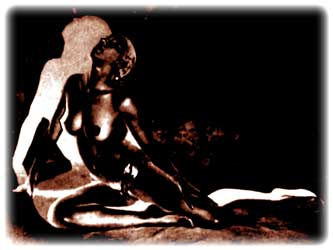
the Harlem Dancer: A line by line analysis
Before we begin our analysis, we want to note that the poem “the Harlem Dancer” is a Shakespearean sonnet, par excellence. Some have suggested that the poem follows a Petrarchan model, and we can understand why—after all, the poem focuses on the beauty of a woman. But the “the Harlem Dancer” clearly follows the rhyme structure of a Shakespearean sonnet, abab-cdcd-efef-gg. A Petrarchan sonnet generally has the following rhyme scheme, abbaabba-cd-ecde. What’s more is “the Harlem Dancer” contains a clear Shakespearean volta in its final couplet, and not a Petrarchan volta which would begin after the second quatrain.
If this were not enough, McKay in his autobiography, A Long way From Home, notes that the missionary who lived in his area as a boy was a “Mr. Hathaway who claimed kinship to the Shakespeare Hathaways, and who started my school-teacher brother (the eldest) on the road to college and gave him his first complete set of Shakespeare.” Though, McKay notes he read Shakespeare mostly for the stories, he was reading Shakespeare at a very early age, and we think it reasonable to suggest he eventually read and studied Shakespeare’s sonnets very carefully. As for whether he read much of Petrarch, we know of no evidence to support this idea.
We want to suggest that not only is “the Harlem Dancer” a near perfect Shakespearean sonnet, but that it actually manages to transcend this form and deliver a message that was at once modern and universal, and yet also informed us of the time and milieu that Claude McKay found himself in, in New York during the second decade of the 1900s.
Now we will begin our line by line analysis of the poem, “the Harlem Dancer.”
the Harlem Dancer, analysis of lines 1 to 4
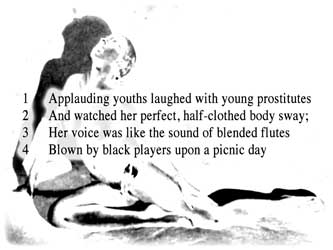
Lines 1 to 4 make up the first quatrain of the poem, “the Harlem Dancer.” We want to start our analysis by making the following points:
• Line 1 immediately impacts us with the setting. With just six words we’re given a very full image of where we are, and what must be happening. (Surely the title of the poem as well, “the Harlem Dancer,” offers a clue.)
• Line 2 quickly gives us the object of the poem, the “the Harlem dancer”. Not only are we given a vivid image but one the fluidly lifts off the page as you read it. The dancer’s “half-clothed body” lends itself to a lot of different thoughts. Is the nakedness demeaning to the dancer? What were the cultural mores at the time in Harlem, and how would this have been perceived? How does the narrator feel about her half-nakedness? Is he stimulated by it or offended by it or both? Is it liberating or exploitive?
• Line 3 compares the dancer’s voice to flutes. There’s something very beautiful and elegant about the sonorous image of blended flutes. It’s a metaphor that suggests something elegant and dignified. This contrasts with a place of laughing youths and young prostitutes.
• Line 4 merely extends the metaphor from line 3. When one thinks of a picnic day one thinks of something bright, cheerful, and innocent. Children run around at picnics having fun. There’s nothing whatsoever seedy about a Sunday picnic. So is the song being sung by the dancer pleasant? And why are “black players” specified? We lack knowledge of what things were like in 1917—would “black players” be playing at a picnic for “whites”? What exactly might be the implication?
• To sum up, the first quatrain introduces us to our setting and the object of the poem the “the Harlem dancer,” and it does so in a way that gives us a strange contrast between something seedy on the one hand, and something delightful and fun on the other.
the Harlem Dancer, analysis of lines 5 to 8
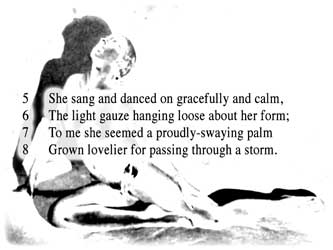
Lines 5 to 8 make the up the second quatrain of the poem “the Harlem Dancer.” We want to continue our analysis with the following points:
• Line 5 reinforces the image of “the Harlem dancer’s” voice as a flute—we learn that she’s graceful and calm.
• Line 6 immediately follows the grace and calm of the preceding line with again the hint of something seedy, light gauze hanging loose about her. Though there is something attractive about light gauze hanging on a form—as its flimsiness highlights the form beneath—the form it is highlighting is that of a clear sexual object. Also, the gauze’s cheapness contrasts with the beauty that lays beneath it.
• Line 7 conjures up the image of a palm tree, something southern and tropic like McKay’s native Jamaica. We’re not sure if palms really do sway, but we’re sure if they do it is indeed with pride and dignity. There is something very stately and dignified about palms. So again, there’s the contrast between the cheapness of the situation, and the grandeur of a palm tree.
• Line 8 notes a storm. But what is the storm? Again this hints at the atmosphere. There are applauding youths laughing with young prostitutes. The atmosphere must surely be rowdy and perhaps even a little raunchy. Yet here is this graceful dancer, keeping her poise despite all this—with both her song and her dance. The fact that despite all the noise and raucous and perhaps even leering, she can keep her grace and calm makes her all the more beautiful, thus she’s “grown lovelier.”
• Summing up, we get all the same contrasts here that we got in our analysis of the first quatrain of “the Harlem Dancer,” but here they’ve all been enhanced.
the Harlem Dancer, analysis of lines 9 to 12
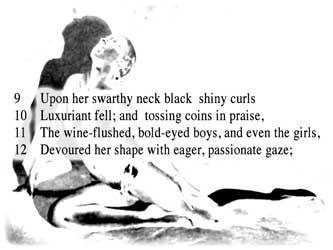
Lines 5 to 6 make up the second quatrain of the poem “the Harlem Dancer.” We’ll continue our analysis with these scattered points:
• Line 9 gives us the image of dark skin and shiny black hair that curls. The purpose of these images is to highlight the attractiveness of the dancer—as an object of attraction.
• Line 10 talks about the curls from line 9 which “luxuriant fell,” one can almost picture a fountain of sorts, a waterfall—but this beautiful elegance is then immediately contrasted against people tossing coins, which comes across as cheap, like coins tossed into a fountain. The women is just an object for these on-lookers.
• Line 11 gives us a really rowdy image of drunken customers with their eyes plastered on this naked dancer, and even the girls can’t help but be attracted to her.
• Line 12 uses the metaphor of consumption, as if the dancer were just some object to be consumed. And the consumers may be be passionate, but there’s something very disturbing about their eagerness.
• To sum up, just as our analysis of the first two quatrains of “the Harlem Dancer” revealed a contrast between the beauty, dignity an elegance of the dancer versus the rowdy atmosphere she finds herself in—this quatrain continues to enhance that theme, driving deeper the message that the “the Harlem dancer” is being treated as an object.
the Harlem Dancer, analysis of lines 13 to 14
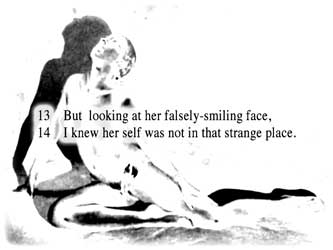
Lines 13 and 14 need to be taken together, and they are very important for our analysis of “the Harlem Dancer.” They represent what is typically called a volta in poetry. They function best when they take the theme of the poem in a different direction than that which had been expected. In a Shakespearean sonnet, typically each of the quatrains sets up a similar train of thought, and then this is turned around or even upside down by the volta.
In this case, we’ve been viewing the dancer this entire time from the outside, as an object of attraction. Even the narrator is guilty of this—the dancer is something to be consumed, whether with passion or even just as a work of art. She’s just an object.
Yet here, we suddenly shift. We have to recognize her not as an object, but as a person. The narrator suddenly becomes introspective, and something is revealed about the inner workings of the Harlem dancer—so that suddenly, she’s not happy and she doesn’t feel comfortable in this place. She doesn’t belong there.
Line 13 notes that her smile contrasts with her song and dancing and comes across as false—suggesting something not quite right.
Line 14 is particularly enigmatic, and wonderfully suggests a variety of different possibilites. “Self” here can refer to soul or personality or inner self—and by “strange place,” this reveals the narrator’s own confused feelings about the place he is in. We will talk more about this when we discuss the meaning of the poem.
This finishes our analysis of “the Harlem Dancer.”

the Harlem Dancer meaning
I want to quote first extensively from Claude McKay’s essay “A Negro Writer to His Critics” [to be found in The New Negro: Readings on Race, Representation, and African American Culture, 1892-1938 edited by Henry Louis Gates and Gene Andrew Jarrett]:
The colored elite thought that if animal joy and sin and sorrow and dirt existed in the Belt as they did in ghettos, slums, tenderloins and such like places all over the world, they had no place in literature … I may well protest publicly that my affection for Afraamerica is profound. During my first couple of years in the states as a student I had a real admiration for the many colored students I came to know and the refined colored society I was introduced into …But it was not until I was forced down among the rough body of the great serving class of Negroes that I got to know my Aframerica … their spontaneous ways of acting on and living for the moment, the physical and sensuous delights, the loose freedom in contrast to the definite peasant pattern by which I had been raised—all served to feed the riotous sentiments smoldering in me and cut me finally adrift from the fixed moorings my mind had been led to respect, but to which my heart had never held.
The irony is that while Claude McKay was criticized by some “modern” contemporaries for his use of classical forms, he was able to take these forms an effectively express universal truths about—as he says—”the great serving class of Negroes.” Until one can escape the lens of seeing McKay’s poetry as an expression of race, and instead, see it as the universal expression of a single human being that has been confronted with racism, discrimination, and exploitation, one will not understand this. Poetry forms don’t arise in a vacuum, nor are they representative of race in some sense—they evolve over time because they suit the language—and McKay was a master of his language, English—thus he was able to make use of these forms.
“the Harlem Dancer” contains at minimum two different themes that twine around themselves into a Gordian Knot, that is both magically and brilliantly cut through in the final couplet introducing yet a third and more important theme. The first theme of “the Harlem Dancer” explores the joy that free and Bohemian lifestyle could bring an individual in Harlem. The second theme of “the Harlem Dancer” explores the unwitting objectification, and thus subjugation, of another person—who might have little choice in the matter. The final and third theme of “the Harlem Dancer” explores how we ourselves are all potentially subjugators, even at times, against our better intentions.
As far as the first theme, we can see from McKay’s own words that he genuinely enjoyed the freedom he found in Harlem. McKay’s biographer, Tyrone Tillery states in Claude McKay, A Black Poet’s Struggle for Identity, “Much like early twentieth-century white bohemians who had impulsively turned their backs on nineteenth-century Victorian morality, McKay imbibed Harlem culture, especially its nightlife. The intimacy, warmth, and native excitement of the cabarets located on 135th Street between Fifth and Seventh avenues enthralled McKay.” We think there is an aspect of the narrator in “the Harlem Dancer” that is genuinely enjoying the spectacle of the “applauding youths,” the mixing with “young prostitutes,” the drinking that’s made the boys “wine-flushed.” The narrator feels he is being liberated from old and parochial values. Artists, in general, are often attracted to Bohemian culture, and we don’t think McKay was any different in this case.
As far as the second theme, the narrator throughout the poem is objectifying the dancer. He’s fascinated by her body, by the way she moves, by the clothes she wears (or doesn’t wear)—her voice is compared to the noise of a musical instrument, an object. Her movement is compared to a palm tree—another object. The narrator is obsessed by the dancer’s hair and skin. We have to ask, is the narrator any better than the youths or the prostitutes that “devour” the “the Harlem dancer” with their gazes? He is one with them, imbibing the Bohemian culture, and completely objectifying the dancer.
As far as the third and final theme, suddenly in the last two couplets, the narrator does an about face. We see the world from inside the dancer. And, suddenly, we see the dark side of the Bohemian culture. The cheapness that until now has only been suggested by such things as “tossing coins” and “gauze” now comes to full bloom. This magnificent beautiful dancer is not happy—she smiles falsely. She doesn’t belong in this “strange place.” We suggest the narrator describes this place as strange because he is at once attracted by it and repulsed by it. He wants to be liberated from his traditional values and to enjoy the Bohemian culture, but in doing so, he realizes he’s becoming an exploiter. This seems to be the ultimate theme of the poem, that we ourselves are capable of exploitation—that even the appraisal of beauty is not free from it.
One can take the theme of the poem, “the Harlem Dancer” and perhaps agree with it or disagree with it, but we think that however that may be, the poem stands as a clear testament to Claude McKay’s poetic talent.

We hope you’ve enjoyed this analysis of “the Harlem Dancer.” If you haven’t yet done so, then don’t forget to subscribe to our updates. Please come back soon!